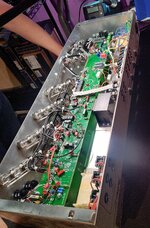Hey brother They all sound great with some slight differences, Some of the earlier ones have a slightly different tone Lots of guys have the technical reasons why to me they seem slightly dryer and tiny bit less compressed. I have owned a bunch and toured with a few through the years. They are all great my only beef is the american 2005-2006/7ish models. Anything else they all slay and kick ass! Btw the el 34s or 6l6 in my opinion sound better mine now has kt77's and its killer in the studio. It has a slightly more fizzy top end that some people love (In my opinion) Once these blow up (3 years going strong) I'm going 34's You can't go wrong either way. Pappa knows what he's doing, The quality, Sound, and versatility is something special. It's one of those amps you need to play with the boys and here it in the context of the band or a mix to really get it. All the revisions you can get them sounding almost the same by boosting the master and lowering the channels or vice versus, Crank the presence or lower the treble etc. Also man for what it's worth i find the vh4 likes lower output pickups but it all works with this beast.

